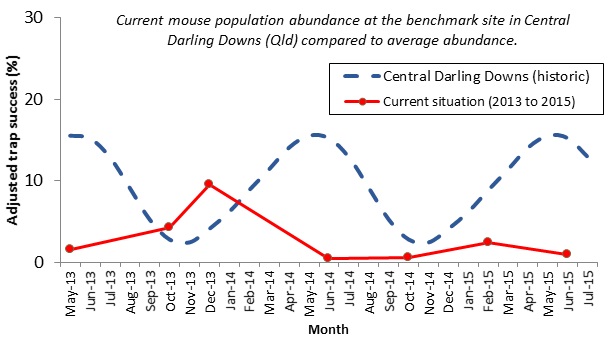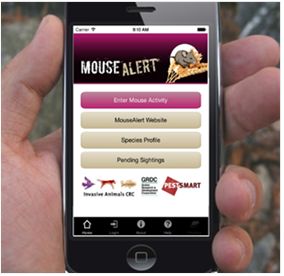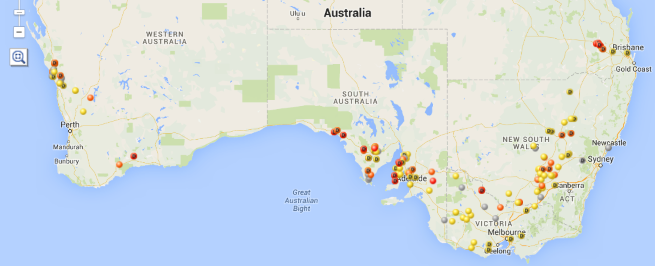Surveillance and forecasts for mouse outbreaks in Australian cropping systems
Author: Julianne Farrell & Peter Brown, CSIRO | Date: 31 Jul 2015
Take home message
- Successful mouse management requires growers to be PROACTIVE rather than REACTIVE
- High numbers of mice are predicted on the Darling Downs during summer 2015-2016
- Use MouseAlert to record mouse activity
Introduction
Mouse populations are monitored on a seasonal basis in grain farming systems in Qld, NSW, Vic, SA and WA. The monitoring provides data on the size (abundance) of mouse populations, their breeding status and activity in crops, fallows and roadside verges.
The Darling Downs transect, which runs between Mt Tyson and Cecil Plains is a benchmark site where live trapping data is collected for use in plague prediction models. The central Queensland (Callide and Dawson transects) and northern NSW (Moree transect) have been used as quantitative rapid-assessment sites using oil cards and active burrow counts.
A sustainable national monitoring network
The surveillance network has been designed to collect data using a variety of techniques, including kill and live capture trapping, oil cards, burrow counts and farmer/agronomist reports. The data set is now sufficient for a comparative assessment of these techniques during the final phase of the project. Evaluation of the rapid-assessment techniques (oil cards, burrow counts) is essential for future low-cost monitoring during periods with a high risk of mouse outbreaks.
Qualitative observations provided by growers, agronomists and other farm advisors will continue to provide up-to-date information and extensive coverage that is critical for an effective, sustainable monitoring network. The MouseAlert website and app were developed within the Invasive Animals CRC and launched in 2014. MouseAlert allows farmers and agronomists to record their observations of mouse activity. Recent reports can also be viewed, and it provides access to factsheets and forecasts of the likelihood for future high levels of mouse activity in each grain growing region.
Recent mouse monitoring results
Darling Downs: There was very little activity on the transect in June (Fig.1), apart from isolated paddocks of sorghum stubble at the Mt Tyson end. The early wheat and chickpeas appeared untouched. Mouse abundance is likely to remain low, however growers should be vigilant as crops mature.
Central Qld: No activity on either the Callide or Dawson transects.
Northern NSW: No activity north or south of Moree, and one paddock of barley in the Pallamallawa area with significant activity.

Figure 1. Recent trapping results for the Darling Downs (2013-2015) shown in red.
Currently, the project provides forecasts of the likelihood of mouse plagues using data from routine surveillance in models that have been developed progressively over the past 20 – 30 years. A new spatially-explicit model has been developed and tested with a data set representative of south-eastern Australia. The model translates current observations into consistent ‘low’, ‘medium’ and ‘high’ levels of mouse abundance. The model then predicts the likelihood that mouse abundance will stay at the same level or change during the next season. These predictions are made for 30km x 30km ‘grid cells’ and the model will initially be implemented for south-eastern Australia.
MouseAlert
MouseAlert is an on-line tool for recording and viewing recent mouse activity across all grain growing regions of Australia. Mouse Alert is a mobile phone app accessible by smart phones (Fig.2) or through the internet via desktop and tablet computers. Growers and advisors can access Mouse Alert through www.mousealert.org.au or download the FeralScan app which features MouseAlert (available in the iTunes store). The MouseAlert web site provides access to fact sheets about mouse control and forecasts of the likelihood for future high levels of mouse activity in each grain-growing region.
The first ever ‘Mouse Census Week’ was conducted in April 2015 to generate interest in MouseAlert and to get a snapshot of mouse activity across the main grain growing regions of Australia. This generated considerable interest, and there are now about 300 records of mouse activity.
Researchers will be using the data collected through MouseAlert to modify existing forecasting models and to explore whether such information can be used to monitor and forecast mouse problems in the future (Fig. 3). MouseAlert was developed by the Invasive Animals CRC through the GRDC mouse monitoring and modelling project in conjunction with Landcare Research and CSIRO.

Figure 2. MouseAlert smart phone app www.mousealert.org.au

Figure 3. There are 300 records in MouseAlert showing low, medium and high mouse activity and locations where damage is evident (D).
Acknowledgements
The research undertaken as part of this project is made possible by the significant contributions of growers through both trial cooperation and the support of the GRDC, the authors would like to thank them for their continued support.
Contact details
Julianne Farrell
Ph: +61 411 257 831
Email: juliannefarrell17@gmail.com
Dr Peter Brown
Ph: 02 6246 4086, 0406 753 365
Email: peter.brown@csiro.au



GRDC Project Code: IAC00002,
Was this page helpful?
YOUR FEEDBACK
